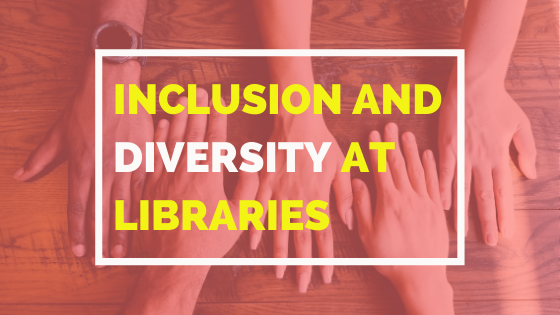The importance of diversity, cultural sensitivity and awareness has increased in the recent years, as more and more hate crimes are being reported.
With this topic in mind, this post will explore how public and school libraries can promote diversity and help students discover and explore unfamiliar perspectives.
Diversity as a value for libraries
What is the background and meaning?
In the words of Dr. Matt Finch; “Libraries are innately subversive institutions born of the radical notion that every single member of society deserves free, high quality access to knowledge and culture.”
Diversity is a fundamental value for libraries as it helps students develop critical thinking and analytical skills while advancing in different literacies. Diversity includes cultural awareness and topics such as identity, race, ethnicity, disability, gender, class, religion, and types of family. Since libraries are nuclear social points, they should play an important role in developing respect for other people from diverse cultural and linguistic backgrounds. Diversity in library programs could allow the visitors and students to develop cultural literacy or appreciation of their culture as well as others.
Furthermore, libraries offer accessibility to educational resources for all visitors. This is especially beneficial for visitors who are struggling with language related barriers, economic distress, or cultural isolation. The American Library Association mentions that libraries “can and should play a crucial role in empowering diverse populations for full participation”.
Promoting diversity in libraries
How do libraries promote this value? And how can your library do that as well?
It is a universal rule that Universities and Libraries value the principles of diversity, equity, and inclusion (DEI). This means that the members of educational centers have responsibility for creating and maintaining a welcoming and inclusive workplace environment where all people can feel they belong.
The American Library Association has highlighted ways in which libraries can promote diversity and alleviate the cultural or linguistic barriers. First, culturally appropriate material that sincerely portrays new cultural experiences is crucial for cross-cultural connections. Relevant and appropriate material will help the visitors get more background and increase the level of cultural awareness. Next, ALA has mentioned the need to provide support for any community events that highlight cultures. Libraries are safe and bonding nuclei; thus, they are a perfect venue to promote equity and create a culturally responsive learning place, which many libraries do already.
Other ways libraries can help with and encourage cultural awareness is to have a staff that is also diverse. A diverse library staff can be a visual representation to help library visitors feel represented in their community library. Studies have also shown that representation is important for a comprehensive learning process. The study was conducted by three educators who implemented, as a result, a cataloging system to make the library collection more diverse and inclusive. They also suggested types of material and books most of the libraries would need for diversity and inclusion. Their conclusion was that books with intersecting characters, characters with different backgrounds, sexuality, family structures, and disabilities should be included in the library collections. Moreover, it was important to have material that could also focus on the perspectives of people of color to deliver more cultural insights to the reader.
The educators highlight that when students feel represented and see similar identities in the material they consume, their interest and enthusiasm towards the subject rises. Another report from the Association for Library Service to Children has an in-depth analysis of why inclusion and diversity are important elements in the learning process. The report mentions that “One way that children learn about the world around them, and other cultures is through the social messages found in stories. Stories help children understand how society perceives their culture as well as the cultures of their classmates, teachers, caregivers, and others, thereby influencing their social and identity development.”
Thus, if your library wants to improve the services it is providing to be more diverse or inclusive, it is a good idea to start by talking and interacting with the library visitors and community. Based on those conversations and insights, libraries and library staff can improve and provide appropriate material and try to fill in the gaps to be as diverse and inclusive as possible.
More on diversity in the Workplace
The American Library Association has conducted a comprehensive study of gender, race, and age in the library profession called Diversity Counts in 2007. The findings revealed that library technicians and assistants are predominantly female, white, and are not limited by disability.
The updated study in 2012 disclosed that there were very small gains in raising the percentage of minority workers in libraries- from 11% in 2000 to 12% in 2009-2010 – in the percentage of racial and ethnic minorities working as credentialed librarians in the nation’s public, academic and school libraries.
Even though it is great to see progression, and the strong strategic plans that have been created to further raise cultural awareness and diversity principles within libraries, let’s hope libraries continue to progress. Libraries are a place that communities look to for guidance and it would be nice to see libraries lead the way with inclusion and diversity for the community.
Madalina Chelaru
Madalina is a content writer for the Princh Library Blog. Princh, which is a printing solution designed specifically for and with public libraries, makes a consistent effort to provide advocacy for libraries and library professionals. The Princh Blog discusses library specific topics that inform their readers of library trends, insights, technologies and more.
Recent posts
Enhancing User Experience For Libraries In The Digital Age
In this week's Princh Library Blog post, recurring guest writer Sam L. Bowman covers how your library can improve the user experience on [...]
Library Password Practices—Balancing Accessibility and Security
In this week's Princh Library Blog, recurring guest writer Nina Grant discusses a basic, but nevertheless crucial digital security principle: secure password [...]






interesting read